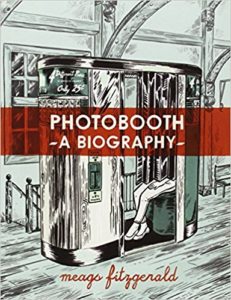Synopsis
For almost a century chemical photobooths have occupied public spaces, giving people the opportunity to quickly take inexpensive, quality photos. In the last decade these machines have started to rapidly disappear, causing an eclectic group of individuals from around the world to come together and respond. Illustrator, writer and long-time photobooth lover, Meags Fitzgerald has chronicled the photobooth’s fortuitous history and the events which gave rise to the desperate need to save them. Having traveled in North America, Europe and Australia, she’s constructed a biography of the booth through the eyes of technicians, owners, collectors, artists and fanatics. In this ground-breaking book Fitzgerald struggles with her own relationship to these fleeting machines, while looking to the future.
From: Meags Fitzgerald
Notes on This Title
For a more in-depth exploration of the author’s sexuality, see Long Red Hair.
Awards
2015 Expozine Award for Best Book - Nominee
2015 Doug Wright Spotlight Award
Reviews
“This graphic novel tells the story of interdisciplinary artist Meags Fitzgerald’s unexpected love affair with “boothing,” as she becomes addicted to tracking down photobooths in the wild (in malls, at train stations, etc.) and letting them capture her in moment. Very quickly, her interest in photobooths evolves, first into an artistic quest, and then into an anthropological endeavour. She travels the world seeking to experience and learn about as many different varieties of photobooths as she can, as well as the unique and independent cultures that have spawned around their existence. On the technical side of things, Fitzgerald takes the narrative all the way back to the invention of the Daguerreotype in 1839, documenting the advances in photographic technology that eventually led to the construction of the world’s first photobooth, which opened in New York City in September of 1925. The book quickly reveals itself to be a three-way biography: of the photobooth’s evolution, of the nations and cultures documented by the existence of photobooths, and of the author as she discovers what photobooths mean to her both as an artist and a person.Using the graphic novel format to tremendous effect, Fitzgerald has created a tertiary layer of personality. Many of the book’s images are carefully rendered translations of actual photographs. This technique acts as a filter that slips between the text and the images to offer the reader a degree of subjective truth that might otherwise have been lost. Additionally, through both her illustrative work and her colourful-yet tothe- point writing, Fitzgerald manages to make every character — major, minor, historical — feel unique and important. Fitzgerald has crafted a book that pays loving tribute to this endangered artistic pursuit while simultaneously being a work of art itself.” (Source: Broken Pencil)
“Not exactly a graphic novel, Photobooth is more a documentary on paper: an illustrated account of a young artist embracing both her medium and muse, interwoven with the history of photobooths from their origins in the 19th century to their current Internet- and smartphone-driven decline. There is no irony in Fitzgerald’s treatment, only unabashed love. For the author, photobooths are a means to explore an intimate relationship with time and a sense of self.” (Source: Quill & Quire)
“In this graphic history-cum-memoir debut, Fitzgerald journeys around the world to find old photo booths and help other enthusiasts catalogue and preserve them, capturing her own lifelong fascination with the chemical development techniques that they used. As Fitzgerald points out, images from chemical photo booths offer a fleeting serendipity, privacy, and beauty that can’t be found in digital photography. She begins the book with Anatol Josepho, who fled World War I–era Russia before inventing the photo booth process in New York City, and traces the history of the technique all the way through contemporary artist Herman Costa, who uses photo strips in his collage art. The story is told mostly through text, but b&w illustrations enhance it, giving the photo strips a visual presence. While Fitzgerald largely relates her tale in a matter-of-fact way, the occasional moments of drama, such as when she weeps over the loss of half of the Paris Metro’s booths, are more powerful because of the contrast. Few will share Fitzgerald’s fervor for this particular obsolete technology, but her passion speaks to powerful universal themes relating to art and memory.” (Source: Publishers Weekly)
